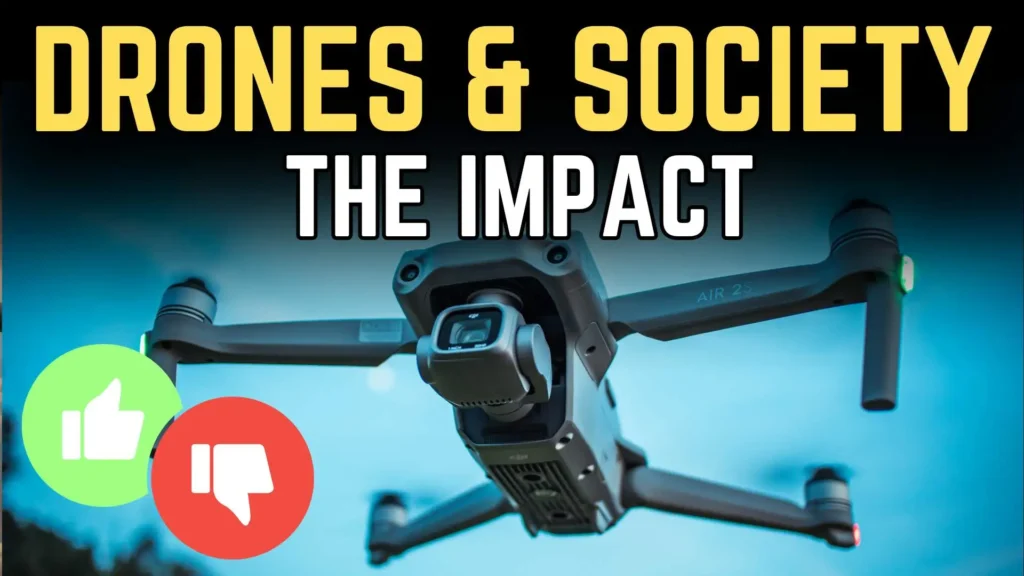Are Drones a Positive or Negative Influence on Society?
Drones, often referred to as unmanned aerial vehicles (UAVs), have taken center stage in the technological landscape, impacting various sectors from entertainment to military applications. As their popularity continues to soar in 2024, the question arises: Are drones a positive or negative influence on society? While drones offer significant advantages, such as improved logistics, innovative uses in industries like agriculture and healthcare, and new opportunities for aerial photography, they also bring challenges, particularly around privacy, safety, and ethical concerns. In this article, we will explore the various dimensions of how drones are shaping our world and whether their influence is more beneficial or detrimental.

Important Statistics related to Drones
- Global Drone Market Value: The global drone market was valued at approximately $30 billion in 2022 and is expected to reach over $58 billion by 2026, growing at a CAGR (Compound Annual Growth Rate) of around 13.8% .
- Commercial Drone Usage: By 2024, commercial drones are expected to account for more than 70% of the global drone market. Industries like agriculture, construction, and logistics are the biggest adopters, with drones being used for tasks like crop monitoring, surveying, and delivery .
- Agricultural Drones: Drones are revolutionizing agriculture, with the global agricultural drone market expected to grow from $1.2 billion in 2020 to approximately $6 billion by 2030, as they assist with precision farming techniques like crop monitoring, soil analysis, and spraying .
- Drone Delivery Expansion: As of 2023, drone delivery services have experienced rapid growth, with companies like Amazon, Google Wing, and Zipline performing over 500,000 successful deliveries globally . This figure is expected to rise as more companies integrate drones into their logistics operations.
- Drone Regulations: In the U.S. alone, there are over 870,000 registered drones, including both recreational and commercial drones, according to the Federal Aviation Administration (FAA). Out of these, over 300,000 are commercial drones registered for business use .
The Positive Impact of Drones
Drones have brought about transformative change across multiple sectors, improving efficiency, safety, and innovation in ways we couldn’t have imagined a decade ago.
1. Enhancing Logistics and Delivery
One of the most significant benefits of drones is their ability to revolutionize logistics and delivery systems. Companies like Amazon and Google are actively developing drone delivery services, capable of delivering goods within minutes. In rural or hard-to-reach areas, drones are becoming vital tools for delivering medical supplies, food, and essential goods, where traditional transportation might be slow or impossible. In 2024, the adoption of drones for delivery services has significantly cut down on delivery times, reduced human labor costs, and contributed to lower emissions, as drones consume less energy than traditional vehicles.
This shift toward drone-powered logistics is particularly crucial during natural disasters or health emergencies. For example, during the COVID-19 pandemic, drones were used to deliver medical supplies to isolated communities, proving their worth in critical situations.
2. Revolutionizing Agriculture
In the agricultural industry, drones have ushered in a new era of precision farming. With the ability to monitor crops from the sky, drones can collect data on plant health, moisture levels, soil quality, and pest infestations, helping farmers optimize their yields and reduce waste. Equipped with advanced sensors, drones can even identify the exact areas of farmland that need more irrigation, fertilizer, or pesticide, leading to more efficient use of resources.
Drones have not only increased productivity but have also helped mitigate environmental impacts by reducing overuse of chemicals. The real-time data that drones provide can also help farmers adapt to climate change, giving them the tools to better manage their land and crops.
3. Improving Public Safety and Emergency Response
Drones are being used more frequently in public safety and emergency response scenarios. In disaster-stricken areas, drones provide rescue teams with an aerial view of the situation, helping them assess damage, locate survivors, and deliver emergency supplies. Firefighters are also using drones equipped with thermal imaging cameras to track and manage forest fires, ensuring a more effective and safer firefighting response.
Police departments worldwide are starting to use drones for surveillance during major events, search and rescue missions, and even to monitor traffic conditions in real-time. These use cases demonstrate that drones are not just tools for entertainment or delivery, but have become essential for maintaining public safety.
The Negative Impact of Drones
While the benefits of drones are undeniable, they are not without their downsides. Concerns over privacy, security, and the potential for misuse highlight the darker side of drone technology.
1. Privacy Infringements
One of the most pressing concerns surrounding the proliferation of drones is the threat to personal privacy. As drones become more accessible and affordable, the possibility of unauthorized surveillance increases. Equipped with high-definition cameras, drones can capture images and videos of private property or individuals without their consent. This has raised legal and ethical concerns over where the line should be drawn between public use and invasion of privacy.
Several incidents of drones being used for spying on individuals, capturing unauthorized footage of private properties, or even celebrities, have surfaced in recent years. These incidents highlight the need for stricter regulations and privacy protection laws to ensure that drone technology does not infringe upon personal privacy rights.
2. Safety Risks
As the number of drones in the sky increases, so does the risk of accidents and safety breaches. In 2024, there have been reports of drones colliding with aircraft, crashing into buildings, or even causing injuries to people on the ground. Although aviation authorities, like the Federal Aviation Administration (FAA) in the U.S., have established no-fly zones and other regulations, enforcing these rules on a global scale remains a challenge.
Drones are also susceptible to hacking, which presents another safety risk. If malicious actors gain control of a drone, they could use it for illegal activities, such as smuggling or causing damage to critical infrastructure.
3. Ethical Concerns in Warfare
One of the most controversial uses of drones is in military operations. Drones have become an integral part of modern warfare, with countries using them for reconnaissance missions and targeted strikes. While drone warfare reduces the need for human soldiers to be on the battlefield, it raises ethical concerns about the detachment between the operator and the consequences of their actions.
The precision of drone strikes is often called into question, as reports of civilian casualties continue to emerge. Critics argue that drone warfare dehumanizes conflict and lowers the threshold for using military force, as drones make it easier for governments to engage in combat without risking human lives.
The Regulatory and Legal Landscape for Drones
The rapid growth of drone technology has outpaced the development of comprehensive regulatory frameworks. Governments around the world are grappling with how to regulate drone use in a way that balances innovation with safety and privacy concerns.
In the United States, the FAA requires drones weighing more than 0.55 pounds to be registered, and operators must adhere to strict guidelines, including restrictions on flying over people or near airports. In the European Union, similar rules are enforced under the European Union Aviation Safety Agency (EASA). However, despite these regulations, many argue that enforcement is inconsistent, and there are still loopholes that allow for misuse.
Global collaboration on drone regulations is necessary to create a standardized approach that addresses the cross-border nature of drone operations. As drone technology continues to evolve, it will be crucial for policymakers to stay ahead of the curve to prevent accidents, protect privacy, and maintain security.
Conclusion: A Mixed Influence
Drones have undoubtedly made a significant impact on society, bringing about numerous benefits in industries ranging from agriculture to public safety. Their ability to enhance productivity, speed up logistics, and provide critical support in emergencies showcases the positive side of this technology. However, we cannot ignore the challenges they present, including privacy violations, safety risks, and ethical dilemmas, particularly in the realm of military use.
As we move forward in 2024, it is clear that drones will continue to shape our world in both positive and negative ways. The key lies in striking a balance between reaping the benefits of drones while addressing the challenges they pose through stringent regulations, ethical considerations, and continuous public discourse.
Ultimately, whether drones are a positive or negative influence on society depends on how we choose to govern and utilize this powerful technology. The future of drones holds immense potential, but it also requires responsible stewardship to ensure that they serve the greater good.



